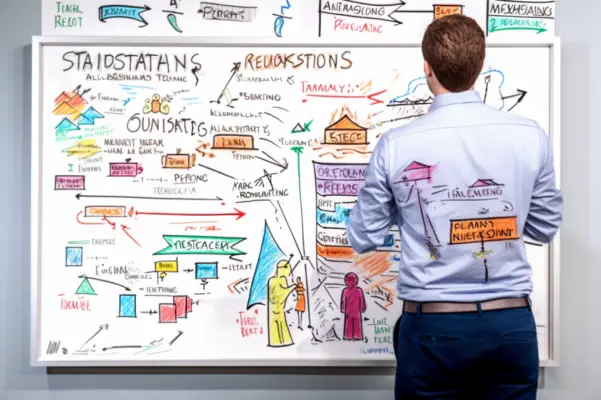Risk management programs are essential to business operations, particularly in today’s fast-paced and dynamic environment. Organizations face numerous operational, financial, legal, and reputational risks, significantly impacting their success and sustainability. Companies must have effective risk management programs that identify, assess, and mitigate potential risks.
One key principle of risk management programs is the identification and assessment of risks. This involves systematically identifying potential risks, understanding their sources and impacts, and assessing their likelihood and severity. Companies can prioritize their efforts and resources using these programs to mitigate the most significant risks and avoid potential losses.
This article thoroughly explores this key principle, examining its application in different industries and contexts and the various techniques and tools used to manage risks effectively.

Identifying and Assessing Risks
Regarding risk management programs, the first step is to identify and assess potential risks. This is important to minimize potential losses and prevent attacks that could hinder a company’s ability to meet its goals. Companies must consider factors such as the risk’s type, source, and impact to identify and assess it effectively.
To effectively identify and assess risks, companies can utilize tools such as risk matrices to help rank risks according to their likelihood and potential impact. Additionally, regular checks should be conducted to identify any undetected risks that may have emerged, and progress on identified and managed risks should be tracked through tools like risk registers or scorecards.
Identifying and assessing risks is a crucial aspect of risk management programs. It allows companies to effectively manage potential risks and minimize losses, ultimately helping them to meet their goals and objectives.
Using tools like risk matrices and regularly checking for undetected risks, companies can stay ahead of potential threats and ensure the success of their risk management efforts.
Risk Management Techniques
Different techniques can be employed to manage risks, such as risk avoidance, cost-benefit analysis, or insurance, depending on the specific needs and goals of a company or organization. Risk avoidance is the best technique to prevent negative consequences, but it may not always be practical or feasible. In such cases, companies may turn to other risk management techniques to minimize or mitigate the impact of risks.
Cost-benefit analysis is a common technique used in risk management. This technique involves weighing the potential costs and benefits of different risk management strategies to determine the most effective approach.
Insurance is another common technique used in risk management. Companies can purchase different insurance policies to protect themselves against various threats, such as property damage, liability claims, or loss of income.
Regardless of the specific risk management techniques employed, companies need to integrate risk management into all parts and activities of the organization. This involves considering the organizational context, involving all stakeholders in decision-making, and maintaining open communication channels.
Early warning indicators should be established to track risks and evaluate their effectiveness. Continual improvement is also essential to ensure that risk management strategies remain relevant and effective. The insurance industry plays an important role in risk management, providing companies the means to transfer risk to other entities in exchange for a premium.
Regular Risk Assessments
Regular risk assessments are crucial for organizations to identify and minimize potential risks effectively while ensuring that risk management strategies remain relevant and effective over time. This key principle of risk management programs helps organizations stay on top of potential threats and vulnerabilities.
Using regular risk assessments, organizations can identify any new or emerging risks, evaluate their potential impact, and prioritize them in terms of their level of risk. This enables organizations to develop effective risk management techniques and strategies to mitigate these risks.
Regular risk assessments involve using a risk matrix or a risk scorecard to identify and rank risks according to their likelihood of occurrence and potential impact. Once risks have been identified and ranked, organizations can develop strategies to mitigate them. This may involve taking steps to avoid the risk altogether, transferring the risk to another party, or implementing measures to reduce the impact of the risk if it does occur.
Regular checks for signs of undetected risks should also be conducted to ensure the risk management program remains effective over time.
Tracking progress is an important aspect of risk management programs and involves using tools such as a risk register, risk matrix, or risk scorecard. These tools enable organizations to monitor the progress of identified and managed risks and evaluate the effectiveness of their risk management strategies. Using this progress, organizations can identify any areas where improvements are needed and adjust their risk management strategies accordingly.
This ensures that risk management programs remain relevant and effective over time, essential for meeting organizational goals and objectives.
Integration into Company Activities
One critical aspect of effective risk management is the integration of risk management practices into all parts and activities of an organization. This means that risk management should not be a standalone department or function but should be integrated into the company’s culture and business. This key principle of risk management programs ensures that all stakeholders are aware of the risks and are involved in managing them.
To effectively integrate risk management into company activities, communication is essential. This includes communication at all levels of the organization, from top management to front-line employees. All stakeholders should be informed about the risks and their role in managing them. This can be achieved through training, regular meetings, and other communication channels.
A dynamic approach to risk management is also important in integration into company activities. Risk management should not be a one-time event but a continual process that adapts to company environment changes. Regular risk assessments should be conducted, and progress on identified risks should be tracked. This ensures that the company is always aware of the risks and takes appropriate action to manage them.

Continual Improvement
Continual improvement is an essential aspect of risk management that ensures the effectiveness of the risk management process over time. It is a principle emphasised in the ISO standard and PMBOK, as it acknowledges the need for a dynamic and responsive risk management team that adapts to changes.
The continual improvement involves regular evaluation and review of the risk management process, with feedback from stakeholders being taken into account.
A supportive culture of questioning and discussing is also important in promoting continual improvement in risk management strategies. This culture involves open communication, transparency in roles and responsibilities, and the authenticity of information used in the risk management process.
The evaluation and review cycle should also consider the limitations and uncertainties in past and present information and anticipate, identify, acknowledge, and respond to changes.
Continual improvement is crucial to the success of risk management programs. It involves a dynamic and responsive team that adapts to changes, regular evaluation and review of the risk management process, and a supportive culture of questioning and discussing.
Continually aligns with other risk management principles, such as involving stakeholders in decision-making, keeping organizational objectives in mind while dealing with risks, and communicating and authenticating information.
| Risk Management Principles | Continual Improvement |
|---|---|
| ISO Standard | The authenticity of information and transparency in roles and responsibilities |
| PMBOK | Dynamic and responsive risk management team |
| Stakeholders | Feedback and open communication |
| Communication | Authenticity of information and transparency in roles and responsibilities |
Frequently Asked Questions
What are some common mistakes or pitfalls to avoid in risk management programs?
Common mistakes to avoid in risk management programs include neglecting to regularly review risks, ignoring low-probability risks, failing to involve all stakeholders, and not adapting to changes in the environment.
How can companies effectively communicate and involve all stakeholders in risk management efforts?
Companies can effectively communicate and involve all stakeholders in risk management by creating a supportive culture of questioning and discussing, keeping organizational objectives in mind, ensuring transparency and inclusivity, and utilizing early warning indicators and continual communication to track risks.
What role does technology play in modern risk management programs?
Technology plays a significant role in modern risk management programs by providing tools for identifying, assessing, and monitoring risks. These tools include risk management software, data analytics, and artificial intelligence, which help make informed decisions and improve risk management strategies.
How can companies balance the need for risk management with the need for innovation and growth?
Companies can balance the need for risk management with innovation and growth by adopting a risk-based approach that integrates risk management into all activities, involves all stakeholders, anticipates changes, and continually improves risk management strategies.
Are there any industries or areas where traditional risk management techniques are not effective or applicable? How can these be addressed?
Traditional risk management techniques may not be effective or applicable in rapidly changing industries or emerging technologies. This can be addressed by implementing a dynamic and flexible risk management approach that adapts to changes and involves all stakeholders.

Conclusion
Risk management programs are vital for businesses to achieve their goals and minimize potential losses from attacks. The first step in risk management is identifying and ranking risks using a matrix, followed by regular checks for signs of undetected risks.
Different risk management techniques, such as risk avoidance, cost-benefit analysis, or insurance, can be used depending on the organization. Understanding risks, including their type, source, and impact, is essential to identify and minimize them effectively.
Moreover, risk management programs should be integrated into company activities and subject to continual improvement. Regular risk assessments are necessary to identify and evaluate new risks and adjust the risk management program accordingly.
The ISO 31000 standard and its eight principles provide a framework for effective risk management. They can be applied to various industries and subjects, such as supply-chain management, occupational safety and health, and talent recruitment and retention.
Organizations can mitigate risks, minimize losses, and achieve their objectives by utilising risk management concepts and techniques.

Chris Ekai is a Risk Management expert with over 10 years of experience in the field. He has a Master’s(MSc) degree in Risk Management from University of Portsmouth and is a CPA and Finance professional. He currently works as a Content Manager at Risk Publishing, writing about Enterprise Risk Management, Business Continuity Management and Project Management.

